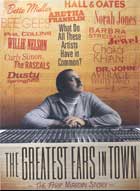
The Greatest Ears in Town 2010
Distributed by TDC Entertainment, 220 East 23rd St., Suite 405, New York, NY 10010
Produced by Joe Mardin and Doug Biro
Directed by Joe Mardin and Doug Biro
DVD, color and b&w, 103 min.
General Adult
Music, Popular Culture
Date Entered: 01/06/2014
Reviewed by Brian Falato, University of South Florida Tampa Campus LibraryThe “ears” referred to in the title of this DVD belong to Arif Mardin, the Turkish-born composer, arranger, and record producer who worked with the top artists in popular music over a 40-year period, starting in the mid-1960s. Mardin’s talents were most often used as an arranger and producer on the recordings of others, but in 2006 he began recording an album that would feature songs he wrote himself, both music and lyrics in most cases. Footage from these recording sessions is interwoven with stories on Mardin’s background and past recordings on which he worked. Interviews with singers Mardin has worked with and his record producer colleagues are also included.
Mardin was born into an aristocratic Turkish family. He fell in love with American music, especially jazz. He met the noted musician Quincy Jones in Turkey, and Jones got him a job composing music for the jazz programs on the Voice of America, the international radio network sponsored by the U.S. government. These compositions, along with Jones’ recommendation, got Mardin a scholarship to the Berklee School of Music in Boston. Mardin’s father was not keen on his son making a career in music, and Mardin initially struggled in New York City after he graduated from Berklee in 1961. Then in 1963, he got a job as a producer’s assistant at Atlantic Records. Mardin was able to work with and learn from men who have since become legends in the music business: Atlantic co-founder Ahmet Ertegun (who also happened to be from a prominent Turkish family), producer Jerry Wexler, and recording engineer (and later producer) Tom Dowd.
Mardin’s goal had been to be a composer and arranger for jazz musicians, but Atlantic gave him the job of arranging the song “Good Lovin’” by The Rascals. The song was a hit, and Mardin soon became the “house arranger” at Atlantic. His career in popular music was further advanced when he became a producer at Atlantic in 1970, working on Brook Benton’s album Today, which contained the smash hit “Rainy Night in Georgia.” Mardin had one success after another as producer and/or arranger, working with such stars as Aretha Franklin, Dusty Springfield, Carly Simon, Average White Band, the Bee Gees, Hall & Oates, Chaka Khan, Phil Collins, Barbra Streisand, Willie Nelson, and Norah Jones. He worked with Jones for EMI Records, after he reached the mandatory retirement age at Atlantic. Jones’ song, “Don’t Know Why,” won the Grammy for Record of the Year and Mardin was a Grammy winner as Producer of the Year, at age 72.
With the exception of Dusty Springfield, who died in 1999, all of the singers mentioned above appear in contemporary interviews in The Greatest Ears in Town, albeit briefly in most cases. They are unanimous in their praise of Mardin, but don’t offer any particularly illuminating tidbits. Mardin also speaks about his work with these stars. He talks briefly about the approach he took with them, and one memorable bit from these segments comes when Mardin tells how the famous falsetto vocal sound of the Bee Gees came about. Mardin wanted lead singer Barry Gibb to put more emotion in the vocal, and suggested he sing an octave higher. The falsetto delivery Gibb developed from this suggestion became a trademark of the Bee Gees.
Many of the singers interviewed also appear in segments working on the recordings for Mardin’s album of his original compositions, eventually titled All My Friends Are Here. They all talk about how challenging Mardin’s music is for them to sing, but the viewer doesn’t get a real feel for many of the songs because the video is usually focusing on just one verse from the song.
Arif Mardin died of pancreatic cancer in 2006. He was still working on arrangements for the album at the very end of his life. His son, Joe Mardin, completed work on the album and serves as co-producer of the video. Joe Mardin provides an additional commentary track on the DVD, but his contributions are mostly limited to telling when a scene or still photo was shot and identifying people in the background of a scene. There are several scenes in the “extras” section, but these are just slightly expanded versions of what we have seen in the main feature.
This DVD will have some popular interest because of the stars included in it, and does provide some insight for students and the general public on what a record producer’s role is. A documentary on Mardin’s Atlantic colleague, Tom Dowd & the Language of Music (2003), is more enlightening because Dowd was an engineer as well as producer and the documentary could show how a record is recorded on the various tracks and then mixed together. Dowd also had an interesting earlier career as a nuclear physicist. Mardin can’t compete with that, but this documentary does open a small window onto the man whose name is on so many famous records.